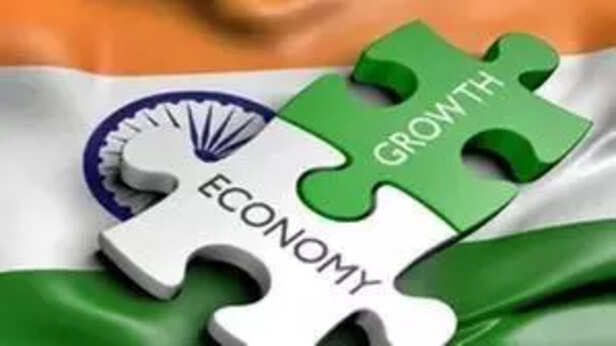India vs Japan: But the Average Japanese Earns ₹2.5 Lakh/Month. Indians? ₹15,000.
Nidhi | May 27, 2025, 21:20 IST
India and Japan Economy
( Image credit : IANS )
India may soon rank as the 4th largest economy, but what about its people? While the average Japanese earns ₹2.5 lakh/month, most Indians earn just ₹15,000—or less. This article dives deep into the real gap between India and Japan: not just in income, but in healthcare, education, housing, and overall quality of life. Economic growth sounds impressive, but do ordinary Indians actually benefit? The answers reveal a striking contrast between global status and everyday survival.
In early 2025, India surpassed Japan to become the world’s fourth-largest economy by nominal GDP. It’s being celebrated as a turning point in global power dynamics.
But behind the headlines lies a harsh truth: the average Japanese citizen earns over ₹2.5 lakh per month, while the average Indian brings home just ₹15,000–₹54,000 depending on the sector. The economic “giant” still grapples with low per capita income, limited social security, and massive inequality.
So, what’s really behind this contrast?
India has a massive economy — but one that supports 1.43 billion people, while Japan supports 125 million.
And even in Purchasing Power Parity (PPP) terms, India does not rank in the top 100 countries by income per capita. 
Japan’s cost of living is about 168% higher than India’s, but it doesn’t fully explain the income gap.
Here’s a real-world comparison of major expenses:
However, the increased income in Japan far outpaces the higher costs, leading to better savings, quality of life, and long-term security.

While cities like Bengaluru, Mumbai, and Delhi offer salaries that touch ₹1–2 lakh per month in top tech and finance sectors, over 90% of India's workforce earns far less, especially in agriculture, textiles, construction, and services.
According to PLFS (Periodic Labour Force Survey 2022–23):

India’s economic growth is real — and should be celebrated. But it’s not the whole picture.
Japan may have fallen to fifth in the global GDP rankings — but the average Japanese lives better, earns more, saves more, and retires with dignity. Meanwhile, millions in India struggle with underemployment, low wages, and insecure futures.
Until India closes the income gap, improves basic services, and boosts productivity, its global economic position won’t reflect in the lives of most of its citizens.
India is a rising nation — but it still needs to become a livable one.
Explore the latest trends and tips in Health & Fitness, Travel, Life Hacks, Fashion & Beauty, and Relationships at Times Life!
But behind the headlines lies a harsh truth: the average Japanese citizen earns over ₹2.5 lakh per month, while the average Indian brings home just ₹15,000–₹54,000 depending on the sector. The economic “giant” still grapples with low per capita income, limited social security, and massive inequality.
So, what’s really behind this contrast?
1. GDP vs. GDP Per Capita — The Numbers Don’t Tell the Same Story
- India’s Nominal GDP (2024): ~$3.7 trillion (₹308 lakh crore)
- Japan’s Nominal GDP: ~$4.2 trillion
- India’s GDP per capita: ~$2,500 (₹2.1 lakh)
- Japan’s GDP per capita: ~$33,950 (₹28.3 lakh)
India has a massive economy — but one that supports 1.43 billion people, while Japan supports 125 million.
And even in Purchasing Power Parity (PPP) terms, India does not rank in the top 100 countries by income per capita.
2. Income Comparison: ₹15,000 vs ₹2.5 Lakh — A Life Apart

Startup founders’ salaries drop over 25 pc in India in FY24_ Report.
( Image credit : IANS )
- Japan: ¥400,000 (~₹2.1–₹2.5 lakh, depending on exchange rate and sector)
- India: ₹54,000 nationally (urban average), ₹15,000–₹20,000 in Tier-2 and informal sectors
- Japan: ¥400,000 (~₹2.1–₹2.5 lakh, depending on exchange rate and sector)
- India: ₹54,000 nationally (urban average), ₹15,000–₹20,000 in Tier-2 and informal sectors
- Median salary in India is even lower — around ₹20,000 per month, indicating the majority earn less than the average.
Healthcare, Education & Quality of Life — India vs Japan
- Japan: 84.7 years
- India: 70.1 years
- Japan: 84.7 years
- India: 70.1 years
- Japan: 99%
- India: 77.7%
- Japan: 99%
- India: 77.7%
- Japan: 10.9%
- India: 2.1%
- Japan: 10.9%
- India: 2.1%
- Japan: Negligible
- India: Over 30% of urban population
- Japan: Negligible
- India: Over 30% of urban population
- Japan: 99%
- India: 94%
- Japan: 99%
- India: 94%
- Japan: Top 5
- India: 117 out of 195 countries
- Japan: Top 5
- India: 117 out of 195 countries
3. Cost of Living: Japan Is Expensive — But India Is Poorer
Here’s a real-world comparison of major expenses:
| Expense Category | Japan (₹) | India (₹) | Japan vs India |
|---|---|---|---|
| Rent (1BHK, city) | ₹90,000–₹1L | ₹25,000–₹30,000 | ~3x higher |
| Utilities (1 person) | ₹8,200 | ₹2,200 | ~3.7x higher |
| Public transport ticket | ₹140 | ₹30 | ~4.5x higher |
| Basic lunch | ₹550 | ₹250 | ~2.2x higher |
4. Infrastructure and Public Services
- Japan: Advanced metro systems, universal healthcare, reliable public transport, clean cities, automated services, elderly care
- India: Expanding metros, improving digital infrastructure, but still lacks consistent electricity, water, healthcare access, and transport in rural regions
5. Workforce, Skills, and Productivity

Japan PM Shigeru Ishiba condemns terrorist attack in Kashmir, says _terrorism cannot be justified for any reason_.
( Image credit : IANS )
- Japan: High productivity, automation, precision manufacturing, R&D-driven industries, aging but highly skilled population
- India: Large workforce, but low productivity, informal sector dominates, limited R&D, lower education and skill standards
- Japan: ~$48
- India: ~$8 (estimates vary due to informal work, but gap is significant)
6. Social Security and Safety Nets
- Japan has one of the world’s best pension systems, public insurance, and unemployment protection
- India’s safety net is limited, with vast portions of the population outside formal employment and without retirement savings.
7. Urban vs Rural Divide in India
According to PLFS (Periodic Labour Force Survey 2022–23):
- Average monthly income for rural casual labourers: ₹10,480
- Urban regular workers: ₹21,000–₹30,000
A Growing Economy Is Not the Same as a Wealthy Society

India's economic growth expected to accelerate in 2nd half of 2024-25_ Report.
( Image credit : IANS )
India’s economic growth is real — and should be celebrated. But it’s not the whole picture.
Japan may have fallen to fifth in the global GDP rankings — but the average Japanese lives better, earns more, saves more, and retires with dignity. Meanwhile, millions in India struggle with underemployment, low wages, and insecure futures.
Until India closes the income gap, improves basic services, and boosts productivity, its global economic position won’t reflect in the lives of most of its citizens.
India is a rising nation — but it still needs to become a livable one.
Explore the latest trends and tips in Health & Fitness, Travel, Life Hacks, Fashion & Beauty, and Relationships at Times Life!
